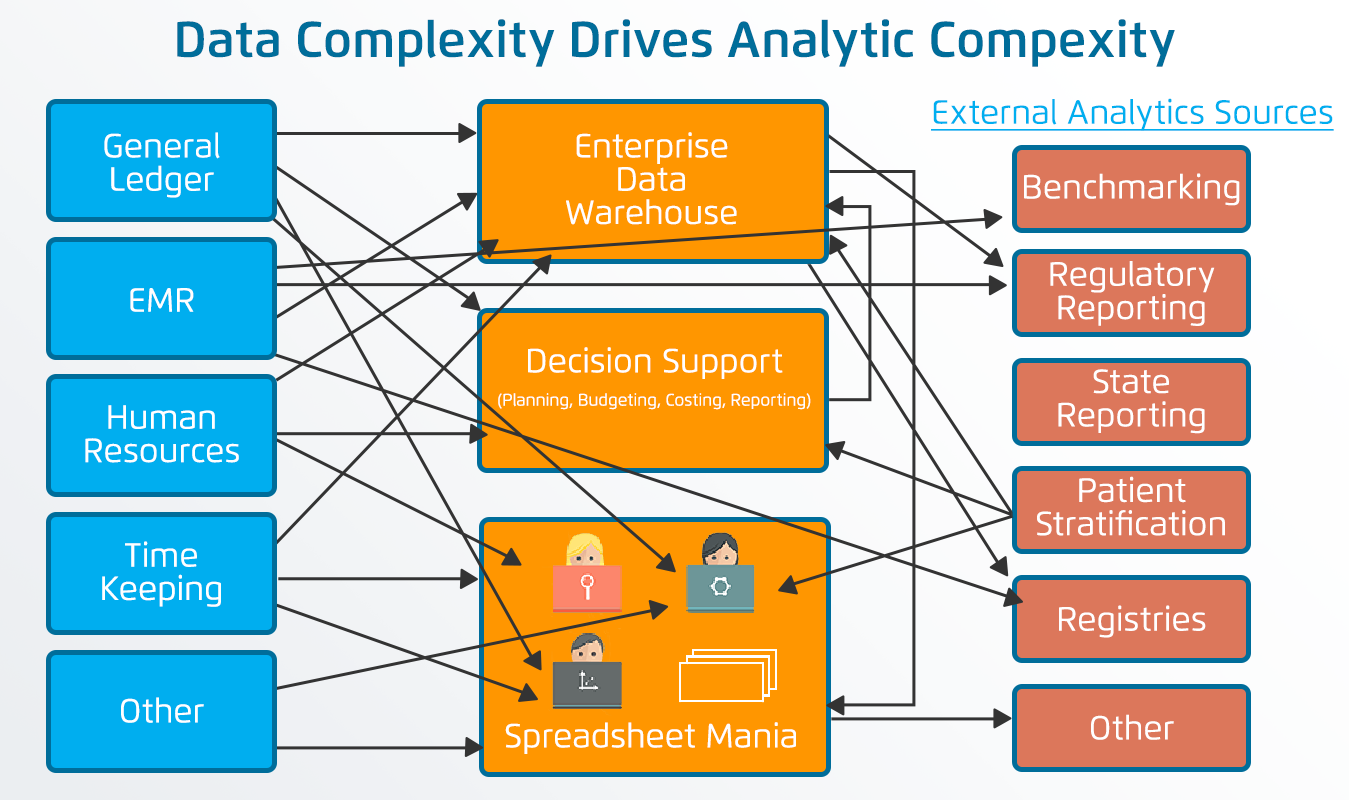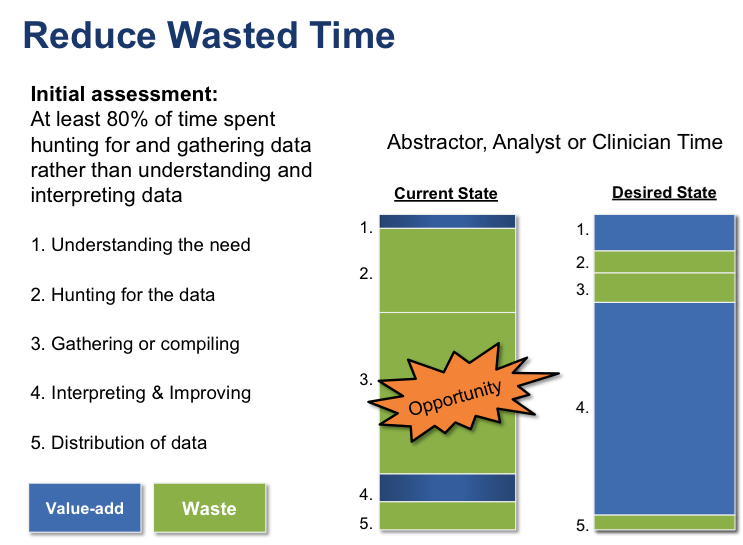Most health systems suffer from data clutter and efficiency problems. As a result, analysts spend most of their time searching for data, not performing high value work. There are three steps that can help you address your data management issues:
1. find all your dispersed analysts in the organization
2. assess your analytics risks and challenges
3. champion the creation of an EDW as the foundation for clinical data management
 Download
Download

They say a sign of an organized mind is a cluttered desk. Either you’re that cluttered genius or you know one in the office. Stacks of files and folders cover the desk, floor, and shelves. Reminder notes stick to any remaining available surface. How you or anyone else ever finds that one needed document remains one of life’s great mysteries.
Another great mystery is how anyone can work with the equivalent clutter in our industry: healthcare data management and clinical data management. Like an office with stacks of paper, healthcare must contend with petabytes of data, spread across numerous disparate systems, with more accumulating every second of every day (Figure 1). It’s been estimated that the volume of healthcare data will grow from 153 exabytes, where it was in 2013, to 2,314 exabytes by 2020. Although we are developing the architecture to handle this volume, clinicians would be wise to remember that more data doesn’t always mean more insight. Sometimes more data is just more clutter.

For the healthcare industry, evolving to value-based care, clinical data management is crucial. Today, to assist an organization in answering its most pressing questions, a healthcare data analyst must navigate a complicated information infrastructure and an increasing volume of data.
The first step in that navigation is to identify the proper data sources. The analyst may work with an IT resource who can help determine which data would be most beneficial to start the analytic process. Collecting raw data from disparate systems is only the beginning. Distilling the information so it focuses on a specific question or strategy enables the analyst to discover more meaningful insights. Leadership, working together with one source of truth, can identify areas for improvement and take quick action to address them.
The standard approach to clinical data management presents two formidable challenges.
Spreadsheet Fever
Many hospital departments have developed DIY tools to confront the profusion of data. They use multiple spreadsheets, often containing information that may be inaccurate or conflicts with corporate data. This leads teams to focus on the wrong priorities or miss improvement opportunities altogether. Source data, once identified and captured, often become shadow systems with one spreadsheet linking to another and then another. This spreadsheet mania further complicates the process and introduces an unnecessary risk for error.
Changing Analytics Roles and Tools
In today’s value-based care environment, data analysts must be equipped with the right tools to identify performance gaps in the organization and create actionable recommendations that drive improved outcomes. Providing the proper infrastructure mitigates the risk of compromising data during capture or transfer. Accurate and timely data is crucial to engaging clinicians and gaining their trust.
As Figure 2 shows, analysts spend roughly 80 percent of their time hunting and gathering data as opposed to performing high-value work, such as interpreting data and making recommendations about how to improve the outcomes.

Most analysts would rather conduct strategic analyses and contribute to organizational decision making. Today, the approach to clinical data management focuses most analytic resources on the task of hunting and gathering. Creating a process that is efficient, effective, and reliable will enable analysts to spend more time on gleaning insight from the data.
Most leaders also dislike the current approach. The multiple pressures of improving care, reducing cost, and planning for the future require near-real-time data. Submitting a request, being placed in a queue, and waiting weeks for a response is no longer an option.
So, how do we change the way data is managed within a healthcare organization to ensure the right data is found quickly and that all the analysts are using that data? Here are three strategies to improve clinical data management.
To align the analysts, a good first step is to simply identify the current analyst pool sprinkled throughout the organization. Finding all the analysts can sometimes be a challenge, but one way is by working with HR to get a list of positions with names similar to “analyst,” “specialist,” or “informaticist.”
Once the analyst pool is determined, elect a core analyst team responsible for assessing the risk within the organization. Some of the team’s new duties, along with the risks they are certain to uncover, include the tasks in the table below:
This initial assessment will clarify the current the level of risk and potential inefficiencies that exist in the analytic organization. This information can be shared with executive leadership to make the case for changing to a new organization model.
There are several analytic organizational models available, including Business Intelligence Competency Center or Analytics Center of Excellence. The most comprehensive model, however, is to align the analysts organizationally. All analysts are members of one analytics department, reporting to a single leader. They provide cross-organizational support, working for various departments as needed.
It can be difficult to implement this model as it can be incredibly disruptive to the organization. The political capital needed to build the organization may also be lacking.
An alternative, less dramatic solution, is to create a central business intelligence group to serve as a consulting group. This group will offer specialized services to functional areas and produce findings to help determine organizational risk and its readiness for change.
Using a data operating system (DOS™) with an enterprise data warehouse (EDW) is a critical step toward a robust analytic infrastructure. The EDW becomes a safe, central repository of data that is organized and optimized for measurement, analysis, and reporting. Sure, this is a large effort, but the payoff is significant and long-term.
The true value of the data warehouse is to organize data, provide links across disparate data sources (so the analysts don’t have to), and provide access so analysts and clinicians can “fish for themselves.” Aligning the analysts and developing clear clinical data governance and management policies will strengthen the entire analytics environment.
For example, the patient identifier provides a valuable link between the EMR data, departmental sources, and patient satisfaction data. After the data is pre-linked, it can be organized in a way that allows for fast reporting and visualization. When used correctly, the EDW becomes the one place analysts rely on for information, creating a single source of truth for the entire enterprise.
Once an EDW is in place, align the analysts and develop some important clinical data governance and management policies to strengthen the entire analytics environment and ensure the greatest return on investment.
Creating a new model that supports effective clinical data management requires DOS and an EDW to assemble and coordinate data from across the organization, providing the foundation to improve care and deliver better outcomes.
This streamlined model greatly reduces lead time, enabling analysts to provide strategic insight from the disparate data collected across various systems. Healthcare organizations that embrace the value of data analytics and harness it to create an effective clinical data management model, will be in the best position to survive and thrive in the new era of healthcare.
Would you like to use or share these concepts? Download this Clinical Data Management presentation highlighting the key main points.